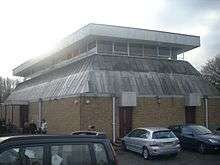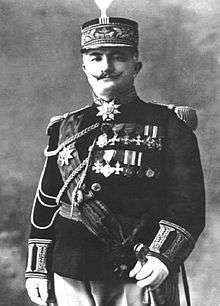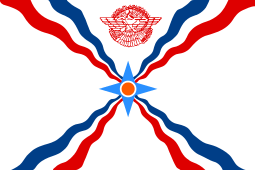British Assyrians
 Fr Habib, the Chaldean Catholic Priest in London | |
| Regions with significant populations | |
|---|---|
|
Mainly London A few in Manchester | |
| Languages | |
| English, Assyrian | |
| Religion | |
| Chaldean Catholic Church, Assyrian Church of the East, Ancient Church of the East, Syriac Orthodox | |
| Related ethnic groups | |
| Assyrian Australians, Assyrian Americans, Assyrian Canadians |
British Assyrians, also known as Assyrian Brits, English Assyrians and Assyrians in the United Kingdom, are members of the Semitic, Eastern Aramaic speaking Assyrian ethnic group (also known as Chaldo-Assyrians and some by the denominational term Chaldean Catholics) born or residing in the United Kingdom. They are the indigenous Non-Arab, Pre-Arab and Pre-Islamic descendants of the ancient Mesopotamians, and the Assyrians, in particular.
Concentrations of Assyrians are found in Greenford and in Hanwell, both towns within the London Borough of Ealing.[1] Assyrians mostly migrated from northern Iraq, southeast Turkey, northwest Iran and northeast Syria, an area encompassing the Assyrian homeland. Migration was largely triggered by long standing ethnic and religious persecution in their homelands.
Religion, ethnicity and culture

Assyrians today still speak Akkadian-influenced Aramaic as a mother tongue. They descend from the ancient Assyrians and Mesopotamians. They are the indigenous population of what is today Iraq, southeast Turkey and northeast Syria.
Assyrian people are exclusively Christian. They fall into a number of Eastern Rite Churches whose services are conducted in classical Syriac, the most common being the Ancient Church of the East, the Assyrian Church of the East, Chaldean Catholic Church and Syriac Orthodox Church.
A Chaldean Catholic Church is rented in Acton, London.[2] The Assyrian Church of the East have its own church, The Ancient Church of the East rent a hall [3] and one Club exist [4][5] are owned by the Assyrians in South Ealing. The priest of the Chaldean Church is currently Father Habib al-Noufaly.[2] The former Chaldean priest was Father Andreas, now a bishop, ordained in Rome by the Pope in 2004.[6] There are between 6,000 and 7,000 Assyrians in the United Kingdom.[7][8]
Immigration history
The earliest recorded Assyrian in the UK was Hormuzd Rassam the famed archaeologist and politician. He became a diplomat in the UK in the mid-19th century and settled in Brighton. The theologian and orientalist Alphonse Mingana was also a notable early arrival in the Edwardian period. Assyrians have traditionally migrated to Britain from their ancestral homelands in Iraq, south eastern Turkey, north eastern Syria and north western Iran.
World Wars

As a result of the Great Game, a diplomatic struggle and "cold war" between the Tsardom of Russia and the British Empire, the Assyrians, Armenians, Arabs and Kurds became involved in the political interference of the Great Powers. All groups sought independence from the aged Ottoman Empire. With the outbreak of the First World War, the Assyrians sided with the British, in the hope of receiving a promised independence.
The Assyrians suffered greatly for this, and hundreds of thousands were massacred during the Assyrian Genocide of World War I at the hands of the Ottoman Turks and their Kurdish and Arab allies. However, at the Treaty of Versailles, the Assyrian delegates were refused entrance; in 1933 the Assyrians suffered one of their worst persecutions when thousands were wiped out in the Simele Massacre by the Iraqi Army.[9] This was in retaliation for assisting the British in the First World War, who occupied Iraq.
Ironically, the Arabs and Kurds had also assisted the British, but only the Assyrians remained loyal to the British as levies. During the British Mandate of Mesopotamia Assyrian Levies were used by the British to protect their interests and to put down Arab and Kurdish insurrections. The outbreak of the Second World War found 40,000 Assyrian soldiers fighting for the British.[10] In the Anglo-Iraqi War, the Assyrians played a decisive role in providing Britain with the much needed manpower to defeat the pro-Nazi Arab rebel forces in the region;[11] another example of Assyrian participation in the war was a mission in Sarandë, Albania in 1945,[12] when 75 per cent of a paratrooper attack was composed of Assyrian troops, the rest being Kurds.[13]
Modern times
Many more Assyrians fled Iraq for the UK during the rule of the Baathist regime from 1963-2003 due to racial persecution, the Baathist Arabs pursuing a policy of forced Arabisation upon the Pre-Arab Assyrians, together with bouts of Ethnic Cleansing and forced relocations. A further influx occurred as a result of the al-Anfal Campaign against Iraqi minorities in the 1980s, and again after the Gulf War (1990–91).
Following the Invasion of Iraq in 2003, more Assyrians fled to the UK in the face of increased religious and ethnic persecution from Arab Islamists and Kurdish Nationalists, including bombing of churches, random killings, violent harassment and kidnappings.[14]
In recent years, the Assyrians have received support from a number of parliamentarians, in particular MP Steven Pound of Ealing and Lord Hylton. Issues raised included the racial and religious persecution of Assyrians by both Kurds and Arabs, and a brief outline of their history since the "Great Game".[15] Assyrians received increased media coverage with the kidnapping and death of a Chaldean Catholic Bishop in Iraq.[16]
Other groups of Assyrians have fled Iran due to religious persecution, Syria due to ethnic discrimination and the recent civil war, where they are violently targeted by Islamists opposed to the Assad regime, and Turkey due to both ethnic and religious discrimination.
Assyrians in London have formed a football club, FC Ealing Assyrians.[17]
See also
- Assyrian/Chaldean/Syriac diaspora
- British Iraqis
- Arab British
- British Iranian
- Lebanese British
- British Jews
References
- ↑ http://www.bethsuryoyo.com/currentevents/AprimAssyriac/AssyriacDenied.html
- 1 2 Watts, Greg (2005-02-05). "At your service". The Times. London. Retrieved 2009-03-19.
- ↑ https://www.facebook.com/Ancient-Church-of-the-East-London-UK-206659252707194/
- ↑ http://newsweaver.co.uk/visitingarts/e_article000311909.cfm?x=b11,0,w mentions an Assyrian club
- ↑ http://www.londononline.co.uk/profiles/14321/#
- ↑ http://www.kaldaya.net/2009/01/Jan27_09_E1_ChaldeanChurch_Vatican2009.html, on the Pope's right
- ↑ http://www.express.co.uk/news/world/560136/The-Assyrian-Christians-a-beginner-s-guide
- ↑ ^ Joshua Project. "Assyrian of United Kingdom Ethnic People Profile". Joshuaproject.net. Retrieved 2013-09-18.
- ↑ "Modern Aramaic Dictionary & Phrasebook" By Nicholas Awde. Page 11.
- ↑ http://www.christiansofiraq.com/Parliament.html
- ↑ http://assyrianlevies.com/gpage8.html
- ↑ http://assyrianlevies.com/gpage9.html
- ↑ https://www.youtube.com/watch?v=lUE5XDEXzmk
- ↑ http://www.christiansofiraq.com/bombed.html
- ↑ http://www.christiansofiraq.com/report.html
- ↑ http://www.catholicnews.com/data/stories/cns/0703209.htm[]
- ↑ http://www.webcitation.org/query?url=http://www.geocities.com/eafc2001/news.htm&date=2009-10-25+21:35:38

